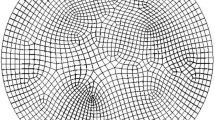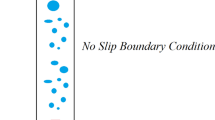Abstract
Since machine learning and smart methods can be used to study hydrodynamics in the bubble column reactor, it is possible to create highly intelligent bubble column reactors that have not been previously simulated and optimized them with computational fluid dynamics (CFD) methods. The previous studies considered the position of each node (in three directions) inside the bubble column reactor as the input in the artificial intelligence model. Machine learning methods have been used for processing big data related to the bubble column reactor. These big data are associated with the points inside the bubble column reactor, which represent the gas volume fraction and the fluid velocity in the x-direction. In this study, adaptive-network-based fuzzy inference system (ANFIS) was used to find out the relationship between the outputs of the bubble column reactor. The present study also intends to investigate the relationship between two outputs, namely the amount of gas in the bubble column reactor and the velocity of the fluid in the x-direction. Various parameters were investigated in this system, including the number of rules, the type of membership function, and the amount of input data. The mentioned parameters were regularly changed to find out the state where the system can achieve its intelligence. In this study, the best parameter that helped the system was the amount of data in the training process. The results showed that the lower the amount of data used in training, the better the prediction.







Similar content being viewed by others
Abbreviations
- C D :
-
Coefficient of drag force for dispersed phase (–)
- C TD :
-
Turbulent dispersion coefficient for dispersed phase (–)
- \(C_{\varepsilon 1}\) :
-
Turbulent dissipation energy equation (–)
- \(C_{\varepsilon 2}\) :
-
Turbulent dissipation energy equation (–)
- \(C_{\mu }\) :
-
Constant in turbulence modeling of dispersed phase (–)
- \(C_{{\mu ,{\text{BI}}}}\) :
-
Constant in bubble-induced turbulence modeling of dispersed phase (–)
- d B :
-
Dispersed phase size (m)
- D :
-
Size of reactor (m)
- D S :
-
Ring sparger size (m)
- g :
-
Gravitational force in modeling (m s−2)
- H :
-
Height of reactor in modeling (m)
- k :
-
Turbulent kinetic energy for modeling of dispersed phase (m2 s−2)
- M I :
-
Interfacial force (N m−3)
- M D :
-
Drag force for modeling of dispersed phase (N m−3)
- P :
-
Pressure in the reactor (N m−2)
- MF:
-
Membership function for ANFIS modeling
- RMSE:
-
Root mean square error for ANFIS modeling
- \(\varepsilon\) :
-
Turbulent energy dissipation rate per unit mass (m2 s−3)
- \(\in\) :
-
Phase holdup (–)
- \(\bar{ \in }\) :
-
Average phase holdup (–)
- \(\mu\) :
-
Molecular viscosity (Pa s−1)
- \(\mu_{\text{BI}}\) :
-
Bubble-induced viscosity (Pa s−1)
- \(\mu_{\text{eff}}\) :
-
Effective viscosity (Pa s−1)
- \(\rho\) :
-
Density of phases (kg m−3)
- \(\mu_{\text{T}}\) :
-
Turbulent viscosity (Pa s−1)
- \(\tau_{k}\) :
-
Shear stress of phase k (Pa)
- \(\varepsilon_{\text{g}}\) :
-
Volume of dispersed phase (–)
- G :
-
Dispersed phase
- L :
-
Matrix/Continuous phase
References
Sobrino, C.; Acosta-Iborra, A.; Izquierdo-Barrientos, M.A.; De Vega, M.: Three-dimensional two-fluid modeling of a cylindrical fluidized bed and validation of the maximum entropy method to determine bubble properties. Chem. Eng. J. 262, 628–639 (2015)
Ziegenhein, T.; Rzehak, R.; Lucas, D.: Transient simulation for large scale flow in bubble columns. Chem. Eng. Sci. 122, 1–13 (2015)
Lopez de Bertodano, M.; Lahey Jr., R.; Jones, O.: Turbulent bubbly two-phase flow data in a triangular duct. Nucl. Eng. Des. 146, 43–52 (1994)
Rezakazemi, M.; Razavi, S.; Mohammadi, T.; Nazari, A.G.: Simulation and determination of optimum conditions of pervaporative dehydration of isopropanol process using synthesized PVA–APTEOS/TEOS nanocomposite membranes by means of expert systems. J. Membr. Sci. 379, 224–232 (2011)
Silva, M.K.; d’Ávila, M.A.; Mori, M.: Study of the interfacial forces and turbulence models in a bubble column. Comput. Chem. Eng. 44, 34–44 (2012)
Rezakazemi, M.; Shirazian, S.: Gas–liquid phase recirculation in bubble column reactors: development of a hybrid model based on local CFD—adaptive neuro-fuzzy inference system (ANFIS). J. Non-Equilib. Thermodyn. 2019, 29–42 (2019)
Rezakazemi, M.; Shirazian, S.: Development of a 3D hybrid intelligent-mechanistic model for simulation of multiphase chemical reactors. Chem. Eng. Technol. 41, 1982–1993 (2018)
Dhotre, M.T.; Niceno, B.; Smith, B.L.; Simiano, M.: Large-eddy simulation (LES) of the large scale bubble plume. Chem. Eng. Sci. 64, 2692–2704 (2009)
Rabha, S.; Schubert, M.; Hampel, U.: Intrinsic flow behavior in a slurry bubble column: a study on the effect of particle size. Chem. Eng. Sci. 93, 401–411 (2013)
Şal, S.; Gül, Ö.F.; Özdemir, M.: The effect of sparger geometry on gas holdup and regime transition points in a bubble column equipped with perforated plate spargers. Chem. Eng. Process. 70, 259–266 (2013)
Kumar, A.; Degaleesan, T.; Laddha, G.; Hoelscher, H.: Bubble swarm characteristics in bubble columns. Can. J. Chem. Eng. 54, 503–508 (1976)
Pourtousi, M.; Sahu, J.N.; Ganesan, P.: Effect of interfacial forces and turbulence models on predicting flow pattern inside the bubble column. Chem. Eng. Process. 75, 38–47 (2014)
Díaz, M.E.; Iranzo, A.; Cuadra, D.; Barbero, R.; Montes, F.J.; Galán, M.A.: Numerical simulation of the gas–liquid flow in a laboratory scale bubble column: influence of bubble size distribution and non-drag forces. Chem. Eng. J. 139, 363–379 (2008)
Deen, N.G.; Solberg, T.; Hjertager, B.H.: Numerical simulation of the gas–liquid flow in a square cross-sectioned bubble column. In: Proceedings of 14th International Congress of Chemical and Process Engineering: CHISA (Praha, Czech Republic, 2000) (2000)
Esfandiari, A.; Hosseini Monjezi, A.; Rezakazemi, M.; Younas, M.: Computational fluid dynamic modeling of water desalination using low-energy continuous direct contact membrane distillation process. Appl. Therm. Eng. 163, 114391 (2019)
Azarafza, A.; Ismail, M.S.; Rezakazemi, M.; Pourkashanian, M.: Comparative study of conventional and unconventional designs of cathode flow fields in PEM fuel cell. Renew. Sustain. Energy Rev. 116, 109420 (2019)
Rezakazemi, M.: CFD simulation of seawater purification using direct contact membrane desalination (DCMD) system. Desalination 443, 323–332 (2018)
Muhammad, A.; Younas, M.; Rezakazemi, M.: CFD simulation of copper(II) extraction with TFA in non-dispersive hollow fiber membrane contactors. Environ. Sci. Pollut. Res. 25, 12053–12063 (2018)
Hajilary, N.; Rezakazemi, M.: CFD modeling of CO2 capture by water-based nanofluids using hollow fiber membrane contactor. Int. J. Greenh. Gas Control 77, 88–95 (2018)
Ahmadlou, M.; Rezakazemi, M.: Computational fluid dynamics simulation of moving-bed nanocatalytic cracking process for the lightening of heavy crude oil. J. Porous Med. 21, 539–553 (2018)
Rzehak, R.; Krepper, E.: CFD modeling of bubble-induced turbulence. Int. J. Multiph. Flow 55, 138–155 (2013)
Besagni, G.; Guédon, G.R.; Inzoli, F.: Annular gap bubble column: experimental investigation and computational fluid dynamics modeling. J. Fluids Eng. 138, 011302 (2016)
Laborde-Boutet, C.; Larachi, F.; Dromard, N.; Delsart, O.; Schweich, D.: CFD simulation of bubble column flows: investigations on turbulence models in RANS approach. Chem. Eng. Sci. 64, 4399–4413 (2009)
Jang, J.-S.: Input selection for ANFIS learning. In: Proceedings of the Fifth IEEE International Conference on Fuzzy Systems, 1996. IEEE, 1996, pp. 1493–1499 (1996)
Zeinali, M.; Mazlan, S.A.; Choi, S.-B.; Imaduddin, F.; Hamdan, L.H.: Influence of piston and magnetic coils on the field-dependent damping performance of a mixed-mode magnetorheological damper. Smart Mater. Struct. 25, 055010 (2016)
Rezakazemi, M.; Dashti, A.; Asghari, M.; Shirazian, S.: H2-selective mixed matrix membranes modeling using ANFIS, PSO-ANFIS, GA-ANFIS. Int. J. Hydrogen Energy 42, 15211–15225 (2017)
Schurter, K.C.; Roschke, P.N.: Fuzzy modeling of a magnetorheological damper using ANFIS. In: UZZ IEEE 2000. The Ninth IEEE International Conference on Fuzzy Systems, 2000, IEEE, 2000, pp. 122–127 (2000)
Xu, P.; Babanezhad, M.; Yarmand, H.; Marjani, A.: Flow visualization and analysis of thermal distribution for the nanofluid by the integration of fuzzy c-means clustering ANFIS structure and CFD methods. J Visual 23(1), 97–110 (2020)
Nabipour, N.; Babanezhad, M.; Taghvaie Nakhjiri, A.; Shirazian, S.: Prediction of nanofluid temperature inside the cavity by integration of grid partition clustering categorization of a learning structure with the fuzzy system. ACS Omega 5(7), 3571–3578 (2020)
Shamshirband , S.; Babanezhad, M.; Mosavi, A.; Nabipour, N.; Hajnal, E.; Nadai, L.; Chau, K-W.: Prediction of flow characteristics in the bubble column reactor by the artificial pheromone-based communication of biological ants (2020). arXiv preprint arXiv:2001.04276
Cao, Y.; Babanezhad, M.; Rezakazemi, M.; Shirazian, S.: Prediction of fluid pattern in a shear flow on intelligent neural nodes using ANFIS and LBM. Neural Comput Appl (2019). https://doi.org/10.1007/s00521-019-04677-w
Tian, E.; Babanezhad, M.; Rezakazemi, M.; Shirazian, S.: Simulation of a bubble-column reactor by three-dimensional CFD: multidimension- and function-adaptive network-based fuzzy inference system. Int J Fuzzy Syst 22(2), 477–490 (2020)
Babanezhad, M.; Rezakazemi, M.; Hajilary, N.; Shirazian, S.: Liquid-phase chemical reactors: development of 3d hybrid model based on CFD-adaptive network-based fuzzy inference system. Can. J. Chem. Eng. (2018)
Soroush, E.; Mesbah, M.; Hajilary, N.; Rezakazemi, M.: ANFIS modeling for prediction of CO2 solubility in potassium and sodium based amino acid Salt solutions. J. Environ. Chem. Eng. 7, 102925 (2019)
Dashti, A.; Asghari, M.; Dehghani, M.; Rezakazemi, M.; Mohammadi, A.H.; Bhatia, S.K.: Molecular dynamics, grand canonical Monte Carlo and expert simulations and modeling of water–acetic acid pervaporation using polyvinyl alcohol/tetraethyl orthosilicates membrane. J. Mol. Liq. 265, 53–68 (2018)
Dashti, A.; Harami, H.R.; Rezakazemi, M.: Accurate prediction of solubility of gases within H 2-selective nanocomposite membranes using committee machine intelligent system. Int. J. Hydrogen Energy 43, 6614–6624 (2018)
Jafarizave, M.; Khaleghi, A.; Rezakazemi, M.: Development of CFD model for membrane-based energy recovery ventilators. Chem. Eng. Res. Des. 145, 226–234 (2019)
Tabib, M.V.; Roy, S.A.; Joshi, J.B.: CFD simulation of bubble column—an analysis of interphase forces and turbulence models. Chem. Eng. J. 139, 589–614 (2008)
Hashemi, F.; Rowshanzamir, S.; Rezakazemi, M.: CFD simulation of PEM fuel cell performance: effect of straight and serpentine flow fields. Math. Comput. Model. 55, 1540–1557 (2012)
Joshi, J.: A circulation cell model for bubble columns (1979)
Takagi, T.; Sugeno, M.: Fuzzy identification of systems and its applications to modeling and control. IEEE Trans. Syst. Man Cybern. 1985, 116–132 (1985)
Author information
Authors and Affiliations
Corresponding author
Rights and permissions
About this article
Cite this article
Nguyen, Q., Behroyan, I., Rezakazemi, M. et al. Fluid Velocity Prediction Inside Bubble Column Reactor Using ANFIS Algorithm Based on CFD Input Data. Arab J Sci Eng 45, 7487–7498 (2020). https://doi.org/10.1007/s13369-020-04611-6
Received:
Accepted:
Published:
Issue Date:
DOI: https://doi.org/10.1007/s13369-020-04611-6




